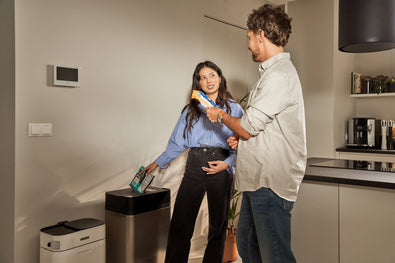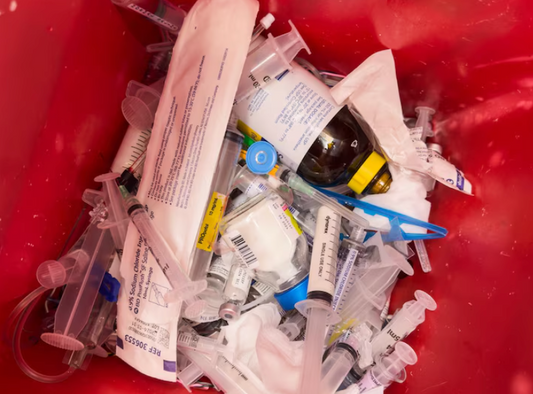ZeroTrash® Revolution Blog Blog
Explore articles on recycling, waste management and sustainable habits by category

Clear Drop: how we’re revolutionizing home waste management
Read
Clear Drop: how we’re revolutionizing home wast...
What if managing household waste was not a burden, but the easiest and most natural thing you do at home? And what if all our waste was actually processed? That’s...
CompostKitchenSoft plasticWaste management
Clear Drop: how we’re revolutionizing home waste management
What if managing household waste was not a burden, but the easiest and most natural thing you do at home? And what if all our waste was actually processed? That’s the question we are addressing at Clear Drop® trying to find innovative solutions for waste reduction in landfills coming from households. We believe that real environmental change starts not with complicated recycling systems, but with smart, seamless solutions. That’s why we’re pioneering the future of pre-recycling: a simple, effective way to prepare waste for recycling right where it’s created with the help of our home appliances. From tricky soft plastic packaging to everyday food scraps, we’re transforming how homes handle waste - and helping people move closer to a Zero-Trash lifestyle. What is more important, we create a system where your soft plastic waste is processed with our partner network of recycling facilities and your organic waste is stored in the way it can still enrich the soil. Why Clear Drop? Clear Drop is a symbol of the neutral impact of humankind on nature. It is a metaphor for what remains after human consumption. Every day we as humans consume food and buy many products in packaging. It results in waste - plastic packaging, empty bottles, paper, glass, cans, organic waste etc. While only a marginal part of that is truly recycled, the footprint of human consumption is very high. The goal of Clear Drop is to reduce this footprint to a single clear drop. A new concept of pre-recycling Pre-recycling is the approach that meets current challenges where the recycling system can’t deal with all types of waste we generate. Pre-recycling means preparing waste for its further efficient recycling before it is dropped into the recycling bin. Currently, some materials tackled by Clear Drop’s home appliances are literally not recycled as soft plastic, not being collected conveniently enough. The regular recycling process is often ineffective: trucks “transporting air”, and labor-intensive separation - together they consume a lot of energy, and resources and create pollution of their own. With pre-recycling, discarded items are conveniently separated and prepared for recycling on the spot facilitating waste reduction. Further on - the material is prepared for storing at home and further delivery to the recycling facilities of our partners. It is cleaner, denser, more convenient for transporting and all-around more manageable for further processing. Moreover, we guarantee recycling. The actual problems we address Challenging soft plastic waste An estimated five trillion plastic bags are used annually worldwide, not including numbers of film packaging and other types of soft plastic. Only 1% of households can recycle film at home today. Less than 10% of soft plastic is recycled, and the data is still not always being calculated and reported. Unlike some traditionally recyclable commodities, such as PET bottles or HDPE bottles, there is not very much publicly available information on the generation and composition of film and flexible packaging.Soft plastic is perceived as a barrier to the efficient process of recycling other types of plastic while being put together in a blue bin for recycling (link to the previous blog post). Soft plastics are lightweight, flexible and inexpensive to produce. This has made them popular choices for packaging. But this ignores the problems of disposal, including harm to nature and people when it ends up in landfills. Unless it’s compacted in a solid substance that changes the process of processing, soft plastics can get tangled or stuck in machinery at recycling or waste-processing facilities, causing inefficiencies and disruptions in the process. Clear Drop solution: compacting soft plastic waste Clear Drop offers the first step in solving this problem – business and home appliances that can prepare soft plastic waste for further transportation and actual recycling. Soft Plastic Compactor (SPC) significantly simplifies the soft plastic collection and transforms fluffy packaging into a shape-preserving 12 × 8 × 4-inch block. It happens with the help of a patented plastic surface-softening technology to keep soft plastic compacted for storage and transportation that is safe for users and the environment. SPC accepts all major types of soft plastic packaging (excluding PVC and PS which are dangerous by nature) like food wrappers, soft plastic containers, shopping bags, cling film, and other types of packaging from your purchases.The device stores around one month of soft plastic waste and provides low energy consumption. The soft plastic prepared by the SPC is easy to pick up and transport, making it more manageable than any other option. The soft plastic block can be emailed to Clear Drop. We offer end-2-end service in collaboration with our recycling partners which adds more possibilities to soft plastic waste reduction in landfills. Dealing with the consequences of organic waste Organic waste is just as harmful to the environment as plastic if it ends up in landfills instead of being composted. When compostable materials, like food scraps and yard waste, are thrown in with regular trash, they end up in landfills. These materials could have been repurposed into nutrient-rich compost to enrich the soil and contribute to waste reducion, but instead, they take up valuable landfill space and contribute to 11% of the world’s greenhouse gas emissions. In landfills, organic waste decomposes anaerobically (without oxygen), producing methane, a potent greenhouse gas. Methane is approximately 25 times more effective than carbon dioxide at trapping heat in the atmosphere, contributing significantly to climate change. Organic waste in landfills contributes to the production of leachate – a toxic liquid that can seep into the ground, potentially contaminating soil and water sources. Composting not only recycles nutrients but also helps sequester carbon in the soil, reducing atmospheric carbon dioxide levels. Without composting, this potential benefit is lost. Organics Collector: new technology to close the loop for organic waste To not let organic waste end up in a landfill people don’t need to do composting by themselves to support waste reduction. Clear Drop makes collecting organic waste at home convenient uninterrupted and without an unpleasant smell, leaks, dissolving organic bags, flies or the necessity to frequently empty the bin with one more home appliances, Organics Collector. Organics Collector (OC) stores and gradually accumulates food waste for several days up to one week. At the same time, the device helps to avoid the appearance of unpleasant odors and insects. Featuring non-energy-intensive processes, the OC consumes very little energy. The unique combination of the O3 generator and filtration system makes sure unpleasant smell is eliminated. Additionally, while stored, the organics in OC undergo a dehumidification process, reducing their moisture content by 30–40%. This makes all OC-collected material easier to transport and pick up and preserves composting features of the material. Once the bin is full, the dried organics can be disposed of at a municipal waste collection point or go to your local or community compost pit. Clear Drop® Founder's Message ‘These are just the first two systems we’re bringing to market. The problem is massive, and Pre-recycling is still in its infancy. But many more solutions are coming. Our promise to the world is that everything processed by our appliances will be recycled — if disposed of properly. We wouldn’t do this if we couldn’t make a difference. Let’s work together to make our future look like a hopeful science fiction story — not the bleak dystopias we risk if we don’t change our approach to waste management.’ Ivan Arbouzov, Founder & CEO of Clear Drop®

Tackling plastic in the healthcare industry: ch...
5 million tons of plastic waste is generated in US healthcare annually The healthcare industry, while vital to human well-being, is a significant contributor to plastic waste. From single-use syringes...
KitchenSoft plasticWaste managementСorporate sustainability
Tackling plastic in the healthcare industry: challenges and solutions
5 million tons of plastic waste is generated in US healthcare annually The healthcare industry, while vital to human well-being, is a significant contributor to plastic waste. From single-use syringes and IV bags, to sterile packaging, PPE, food packaging, regular business operations, and more, the sector relies heavily on plastic materials to ensure hygiene, patient safety, efficiency and convenience. However, this reliance generates vast quantities of plastic waste - much of it non-recyclable due to contamination or mixed materials. According to a report by Healthcare Without Harm, hospitals in the U.S. produce over 5 million tons of waste annually, with plastics making up a substantial portion. To put it in perspective, 5 million tons is the equivalent of nearly 3 million midsize cars! Given the environmental urgency, healthcare sustainability professionals are increasingly seeking ways to reduce plastic use and improve recycling within their facilities. Here are six practical solutions that can make a meaningful impact: 1. Conduct a plastic waste audit A comprehensive plastic waste audit allows healthcare facilities to understand the types and volumes of plastics being used and discarded. By identifying high-waste areas, sustainability teams can target specific processes or departments for improvement. For example, operating rooms are known hotspots for single-use plastics and can benefit from focused interventions. However, we must remember that plastic plays a critical role in modern healthcare, offering numerous benefits like improved sterility, durability, and cost-effectiveness. So it’s important to not instantly demonize plastic, but instead examine how its use can be reduced or how recycling the material can be improved. A good audit will provide insight into opportunities for any healthcare facility. 2. Switch to reusable medical supplies where safe Many plastic products in healthcare are single-use for safety reasons, but some items can be safely replaced with reusable alternatives. Surgical instruments, gowns, and certain types of trays can be sterilized and reused. Hospitals should evaluate which plastic items could be replaced with reusable versions without compromising safety or compliance. 3. Implement recycling programs for clean plastics While contaminated plastics are difficult to recycle, clean plastics—such as packaging from sterile instruments—can often be recycled. Establishing a system where staff can easily separate clean from contaminated plastics encourages recycling. Partnering with specialized recycling companies can also open new avenues for processing healthcare-specific plastics. “As a research institute conducting studies on the impact of microplastics on human health, we analyzed how much non-contaminated plastic waste we were producing ourselves,” said Dr. Charlie Rolsky, Executive Director and Lead Research Scientist at the Shaw Institute in Blue Hill, Maine. “We couldn’t ignore the irony and decided to take action by evaluating how we can reduce that waste and also better ensure that as much of it is recycled as possible. We’re now working with suppliers that offer lower or plastic-free packaging, but we are also soon beginning a pilot program with Clear Drop to test their Soft Plastic Compactor device, which reduces the volume of the waste by about 90% - making it much easier for us to manage and also for recyclers to collect and process for re-use.” 4. Source bioplastics and eco-friendly alternatives The market for biodegradable and compostable medical products is growing. Items such as bioplastic syringes, eco-friendly bedpans, and compostable packaging can replace traditional plastic counterparts. Healthcare procurement teams can prioritize suppliers who offer sustainable alternatives to petroleum-based plastics. 5. Staff training and engagement Sustainability initiatives succeed when staff across all levels understand their role in reducing plastic waste. Regular training sessions, visual aids near disposal areas, and recognition programs for sustainable practices help create a culture of environmental responsibility. Engaged staff are more likely to follow recycling protocols and suggest improvements. 6. Work with manufacturers for sustainable product design Healthcare institutions can leverage their purchasing power to influence manufacturers toward more sustainable designs. This includes advocating for products with minimal or recyclable packaging, modular designs that reduce material use, or take-back programs where manufacturers reclaim used products for recycling. “There’s no single solution to solving the problems that are related to plastic waste,” said Ivan Abrouzov, President and CEO of Clear Drop, Inc. “Whether it’s within healthcare or other industries, many factors have caused the issues we face, especially when it comes to recycling. It will only be through multiple solutions that we can begin to reduce waste, improve recycling and create what we like to refer to as a ZeroTrash® Lifestyle. Our technology and products are a step toward making that a reality. Whether it’s with our products or not, I encourage everybody to be part of the solution.” Reducing plastic waste in healthcare is not without its challenges - safety, regulatory compliance, and cost all play a role in shaping what’s possible. However, by adopting targeted strategies and fostering innovation, the industry can significantly reduce its plastic footprint. Collaboration between healthcare providers, manufacturers, and sustainability experts is essential for developing scalable, practical solutions that protect both human health and the environment.

